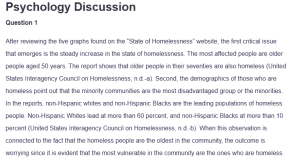Psychology Discussion
Question 1
After reviewing the five graphs found on the “State of Homelessness” website, the first critical issue that emerges is the steady increase in the state of homelessness. The most affected people are older people aged 50 years. The report shows that older people in their seventies are also homeless (United States Interagency Council on Homelessness, n.d.-a). Second, the demographics of those who are homeless point out that the minority communities are the most disadvantaged group or the minorities. In the reports, non-Hispanic whites and non-Hispanic Blacks are the leading populations of homeless people. Non-Hispanic Whites lead at more than 60 percent, and non-Hispanic Blacks at more than 10 percent (United States Interagency Council on Homelessness, n.d.-b). When this observation is connected to the fact that the homeless people are the oldest in the community, the outcome is worrying since it is evident that the most vulnerable in the community are the ones who are homeless. The report also shows that people experiencing homelessness served by the health center program amount to 1.26 million. Also, statistics show that homelessness affects single families the most, while unsheltered individuals show the lack of enough shelters and the inaccessibility of these shelters.
Question 2
The strategy chosen is the first strategy that focuses on integrating equity into the efforts of the federal government to cut down on homelessness to address long-standing disparities in healthcare and economic access of the disenfranchised communities. The strategy also emphasizes inclusivity and racial equity. This strategy also aligns with other broader federal initiatives like President Biden’s executive order on “Advancing Racial Equity” (United States Interagency Council on Homelessness, n.d.-b). This strategy standardizes equity outcomes in various programs through qualitative and quantitative metrics. Additionally, this strategy provides state and local agencies with the necessary guidelines for implementing practices that reduce disparities, ensuring that tools and all online communications are accessible to every individual, including persons with disabilities, and prioritizing diversity in hiring and making federal efforts to prevent homelessness inclusively and transparently and in the end aiming at creating a system that benefits every individual in the community equally.
The implementation of this strategy will likely need more sustained funding, a prominent challenge. Equity-based initiatives often require vital investments to ensure they are not only started but also maintained over time. Moreover, policy shifts may affect such an initiative, especially when a new administration comes to power and does not place emphasis on the initiatives to reduce homelessness (United States Interagency Council on Homelessness, n.d.-b). Another challenge would be resistance from state and local entities that feel that they must agree with the federal equity mandates. Another issue that this strategy might encounter is the need for more clarity in identifying all potential equity barriers across agencies and regions since biases in policy implementation or processes might emerge in the process. When this happens, comprehensive and costly analysis could be necessary. Hence, if cross-sector collaboration is lacking and targeted funding is needed, this strategy may be objectiveless and encounter delays.
Question 3
The Serving Seniors program runs in San Diego and explicitly addresses rising senior homelessness by providing affordable housing. The program runs alongside supportive services like healthcare access and financial planning (Ludden, 2022). Therefore, when the model merges services that meet the needs of older adults with the fight against homelessness, it aims at achieving long-term housing solutions and retention among senior individuals. This model is good and can be used by other cities and states, but the local funding and community support may determine its success.
Question: How can the local government collaborate better with the not-for-profit organizations to address the needs of the homeless people on a leaner budget?
References
Ludden, J. (2022, December 19). ‘It is the obvious thing.’ The White House tries a new tack to combat homelessness. NPR. https://www.npr.org/2022/12/19/1142790156/people-homelessness-crisis-housing-prevention-biden
United States Interagency Council on Homelessness. (n.d.-a). Homelessness data & trends. https://www.usich.gov/guidance-reports-data/data-trends
United States Interagency Council on Homelessness. (n.d.-b). Lead with equity. https://www.usich.gov/federal-strategic-plan/lead-equity
ORDER A PLAGIARISM-FREE PAPER HERE
We’ll write everything from scratch
Question 
In a post, answer the following questions:
Read State of Homelessness and review all five graphics.
- In 150 words, identify one issue in each graphic using information from the Federal Strategic Plan.
Question 2
Read Lead With Equity and choose one of the four strategies listed.
- 2A: In 150 words, give an overview of the chosen strategy.
- 2B: In 150 words, use critical thinking to discuss what may prevent the implementation of the chosen strategy. Support your answer.

Psychology Discussion
Question 3
Read ‘It is the Obvious this’. The White House Tries a New Tack to Combat Homelessness
- In 150 words, explain if/how the Serving Senior program addresses the rise in senior homelessness. Can this model be duplicated in other cities?
- Write one question, related to the content in this module, that you would like the instructor to answer.
Resources:
